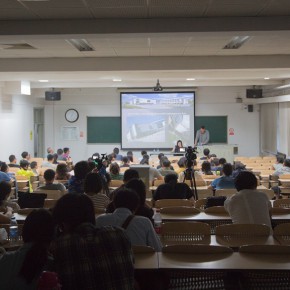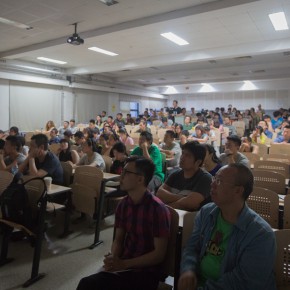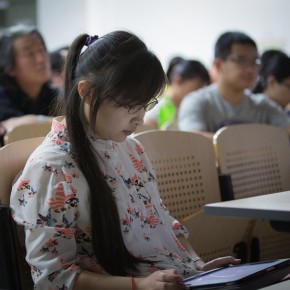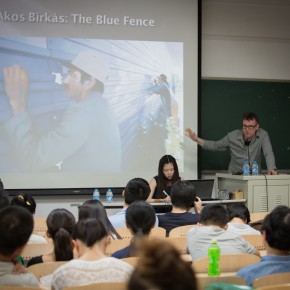
At 6:30 pm on May 20, 2014, Krisztián Kukla, Director of Debrecen Art Museum, Hungary gave a lecture entitled “Phenomenology of Attention - Contemporary Art in Central Europe” at room A107 of building 5 at CAFA.?Krisztián Kukla has always been committed to contemporary art activities, once being responsible for planning the flowing project of the 12th Venice Biennale. He leads the Debrecen Art Museum which is not only an important museum of contemporary art in Hungary, but also an important experimental base for contemporary art in central Europe. In addition,?Krisztián Kukla is interested in Chinese contemporary art, and participated in the exhibition Spectacle Reconstruction Chinese Contemporary Art last November.
Krisztián Kukla’s lecture was mainly divided into three parts. Firstly, from the perspective of philosophy, he combed through the rich meanings of the concept of “attention”, taken as the starting point, around Hungarian contemporary art, especially Debrecen Art Museum, to introduce in detail, the development of contemporary art in Central Europe. He eventually introduced some typical artistic cases. By showing their works, the audience intuitively felt the characteristics of contemporary visual artistic development in Central Europe.
As a philosophy teacher, he knew that the philosophical concept of “attention” was often confusing. He believed that “attention” was deeply and purposefully control; secondly it was an experiment in shocking, which was unexpected, and was only a way of performing about the arrival of things; thirdly, if something changed in an imperceptible way, it would give rise to attention. Such as a faint sound, and facial contour which gradually became clear, etc; fourthly, special attention, which appeared for some reason, where intuition and expectation played a key role. Kukla thought that, “Attention” happened in a specific environment, it won’t answer the issues such as what was the thing, why did it happen, etc. From the perspective of ontology and epistemology, it was the element of the marginal. The marginality meant that “attention” was an intermediate medium, which caused things to happen. It is the thing that exists between sensibility and spontaneity.
Then, he briefly reviewed the philosophical history of “attention”. Since Aristotle, it appeared there were some theories on perception. In the tradition of the ancient West, “attention” is more inclined to be the slaves of people. Augustine believed that “attention” was a kind of pristine intention, namely a person’s intention. In the 17th Century, Descartes summed up “attention” as an action of will, while Locke once described “attention” as a kind of internal testing, which would reveal all the visible things. Compared to the dual theory, Leibniz described the “attention” as a flowing state. He thought that attention was the perception of consciousness. But the “attention” had always played a peripheral role in the tradition of Western philosophy. In the second half of the 19th Century, scientific psychology paid more attention to the “attention”, which was not only an experimental subject, but also an important condition for the experimental method itself – the perceptional definition.
It was easy to find that the root of the word “attention” was consistent with “tension”, namely extended, stretched, waited, which made some stay in a state of curiosity or meditation, while people were the subject inside it, actually in a self-denying disrupted state. Such a state of suspension was very important for contemporary visual art. Gombrich explained the concept of “attention” in his “Phenomenology”, and criticised the tradition of Western philosophy, he thought they often forgot the creative ideas of attention. “Attention” was the whole process for things developing. Thus, in the end of the 19th Century, “attention” became a kind of energy control and the cyclic carrier in the field of visual art.
In the second part of the lecture, Kukla introduced the situation of the MODEM gallery to the audience, and it was both a gallery and a contemporary visual art center, formally established in Debrecen in 2006. The establishment of the organization aimed at becoming the most important place in Hungary for the appreciation of the worldwide contemporary art. Mainly holding contemporary art exhibitions, there were three main exhibition halls, as large as 3000m, in addition to 6-9 temporary halls every year. The largest one was on the 2nd floor, inside there was an audio-visual conference room and a garden. It organized performances and concerts, and carrying out some educational activities for children, where they could study contemporary art. The collections mainly came from the donations of private organizations, meanwhile in order to enlarge the collections it established the connection and cooperation with foreign organizations and artists.
Following this, Kukla talked about the works by a series of outstanding artists closely linked with the Modern and Contemporary Art Center, Debrecen (MODEM). Balazs Antal’s reconstruction plan of the Debrecen Square showcased the visual art experiences on the individual and collective experiences. And the work with the tanks’ structure produced by the female artist Ilona Nemeth, who participated in the MODEM exhibition in 2012, made her public spatial idea enter the public view. Her tank-structure habitations were the smallest living units, provided the homeless, lovers and short-term travellers with living spaces. In addition, Kukla also introduced the artworks by Endre Tot, Gabor Gerhes, Zsolt Ferenczy, Attila Szucs, Lajos Csonto, Zsolt Bodoni, Akos Birkas, and so on.
At the end of the lecture, Kukla mentioned that Hungary was consistent with China in terms of cherishing the tradition, and he said he loved and yearned for Chinese contemporary art. He said, in the cooperation with the China planning exhibition in the recent two years, he felt the vitality of Chinese contemporary art, but also worried about Chinese young artists that were faced with the rapidly changing situations. He hoped that the interaction between Hungarian contemporary art and Chinese contemporary art would benefit each other.
Journalist: Li Fan, translated by Chen Peihua and edited by Sue/ CAFA ART INFO
Photography: Quan Jing/ CAFA ART INFO




































